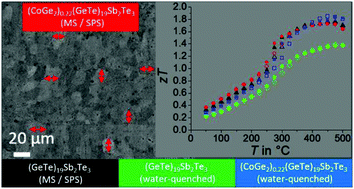Cobalt germanide precipitates indirectly improve the properties of thermoelectric germanium antimony tellurides†
Abstract
Different established synthesis methods such as melt-casting followed by annealing as well as melt-spinning or ball-milling followed by hot-pressing or spark plasma sintering may significantly influence the properties of thermoelectric materials. The comparison of microstructures obtained by different synthesis routes (water-quenching and melt-spinning followed by spark plasma sintering) reveals the indirect nature of the beneficial influence of cobalt germanide precipitates on the thermoelectric properties of germanium telluride and germanium antimony tellurides (GST materials). Cobalt germanide precipitates significantly influence the thermoelectric properties of GST materials: the thermoelectric figure of merit zT of (GeTe)17Sb2Te3 obtained by quenching melts in water increases from 1.6 to 1.9 (at 450 °C) by introducing cobalt germanide precipitates. They drastically reduce the grain and sub-grain sizes of the GST matrix. Melt-spinning followed by spark plasma sintering leads to nanoscopic cobalt germanide precipitates, whose effect on the thermoelectric properties, especially the phononic thermal conductivity, surprisingly seems to be marginal. This is due to the already significantly reduced (sub-)grain sizes in such polycrystalline GST samples as revealed by orientation (“channeling”) contrast in backscattered-electron micrographs. Melt-spun and spark-plasma-sintered GST material exhibits similar thermoelectric figures of merit zT values as water-quenched samples with cobalt germanide precipitates. In addition to providing easier access to samples with small (sub-)grains by simple quenching, the precipitates may stabilize the GST or GeTe microstructure by Zener pinning as cobalt is insoluble in the matrix material. This is very favorable concerning cyclability during thermoelectric measurements and potential applications. The heterostructured materials and their thermoelectric properties are long-term stable. Hall effect measurements of heterostructured GST (melt-spun and spark-plasma-sintered) indicate that the charge carrier concentration is near optimum.



 Please wait while we load your content...
Please wait while we load your content...